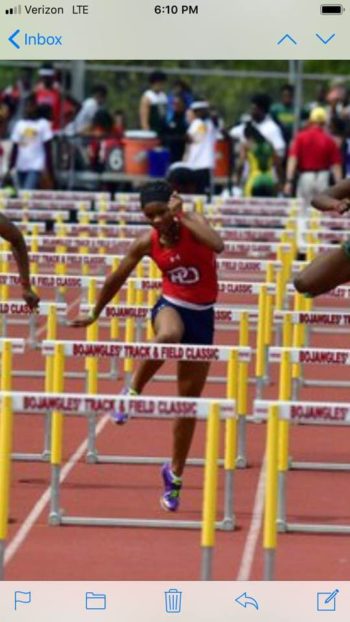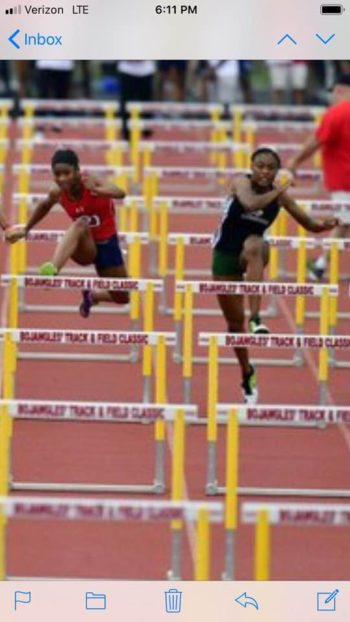Solving the Tilt to the Lead Leg Side
by Steve McGill
A technique-related problem that I’ve been seeing with a few of my athletes is the tilt of the upper body to the lead leg side during hurdle clearance. This tilt is a form of power move—an attempt to forcefully push oneself through the hurdle. It’s not a major problem, a make-or-break problem, but it is a flaw that needs to be addressed. In this article, I will describe what the tilt looks like, what problems it causes, and how to correct it.
[am4show not_have=’g5;’]
[/am4show][am4guest]
[/am4guest][am4show have=’g5;’]
To be specific, the tilt actually occurs during take-off, before the foot of the back leg has left the ground. Let’s take a look at a photo of one of my athlete, Falon Spearman, from a meet earlier this spring.
In the photo, you can see what I mean: the foot of the back leg is still on the ground, and her upper body is tilting to her right, over the lead leg. The tilt is causing her lead leg to flare outward a bit from the knee down; it’s also causing a slight twist in the hips, and it’s also causing her trail arm (or, second arm, as we call it in the cycle-arms style) to open up too much, with the elbow almost locking completely. That trail arm will end up swinging back too far, causing the entire hurdling action to be slowed down. In the past few months, I had noticed that her trail leg foot would kick back after pushing off the ground, her lead leg would extend horizontally more than we wanted it to, and the cycle-arm action wouldn’t be as compact as we wanted it to be. Yes, the arms were cycling, but it was a long, loping cycle action, which kind of defeats the purpose of using that style to begin with.
So I spent a lot of time trying to eliminate what I believed to be back-kick in her trail leg. And I tried getting her to “speed up” the trail leg, to not let it pause after it pushed off. Those solutions seemed to be working in shorter, quicker drills, but not when we went full-speed out of the blocks. Then I remembered the photo above, which her mom had sent me after a meet. And I thought back to last year, when Falon’s trail arm swung back real far, even worse than it does now with the cycle arms. Before it would get back there and pause visibly before punching back up. When I looked again at the photo above, I found the answer to our problem: the tilt. It was causing a ripple effect. I realized that if we got ride of the tilt, we’d get rid of the trail arm opening up so wide, we’d get rid of the lead leg kicking out to the side, and we’d get rid of the trail leg seemingly kicking back. The tilt was causing all of that.
In the photo above, you can see what happens after the foot of the trail leg leaves the ground. Falon’s hips aren’t facing the front; her shoulder’s aren’t facing the front. Her entire torso is tilted toward her right. That’s because that’s the direction she was facing prior to take-off. The lead leg, too, is pointing toward her right. What this means is, at every hurdle, she’s shifting toward the right going into and over the hurdle, then correcting herself and coming back straight ahead as she descends and lands off the hurdle. So, that’s a lot of lateral movement when you multiply it by ten. Again, the fact that it only happens in races tells me that it’s an adrenaline thing, that it’s a body-default thing, meaning that the body goes back to what it knows when the gun goes off. So, in order to address the problem, we had to change what the body knows.
It’s interesting to note, by the way, that in the second photo, the girl in the lane next to Falon is leading with her left leg, and is tilting to her left side just like Falon is tilting to her right side. Just think if they were to switch lanes; they’d be smacking into each other all the way down the track! It’s got me thinking that maybe this flaw is more common than I realized.
Anyway, in regards to fixing the problem:
When addressing any technical issue, we always start low and slow – low hurdles, spaced close together. Gradually, we raise them up and space them farther apart, so that the speed increases gradually as well. The cue I gave her was to take the same energy she was using to tilt, and take that energy forward. Lean forward over the lead leg knee. Keep the hips square and keep the shoulders square. We went through the marching popovers, the cycle drill, and the quickstep drill with no problem. Instantly corrected. But when we put the blocks down and went over the first two hurdles full speed, the tilt revealed itself again. But that was okay; that’s what we wanted to find out. Can’t fix the mistake if we don’t expose the mistake.
Ultimately, she started to get it right even at full speed. What I saw as the coach was a tighter, more efficient action over the hurdles. The cycle arms started looking like I had always envisioned it would look – the second arm cycling right behind the first arm, and the elbow of the second arm was staying bent. The trail leg wasn’t kicking back.
We’ll see how things play out. You can never predict how long it will take for an athlete to be able to execute a technical improvement in the heat of the battle, when there is no time to think. But I feel confident that she’ll be able to implement it at some point this summer, which should take her under 14-flat, seeing as how she has run 14.22 with this flaw.
A male athlete of mine, Matt Garrett, had the exact same issue, and I addressed it in the same manner on the same day I addressed it with Falon. Again, it was a fairly easy fix in practice. Just getting it to translate to races will take time. In Matt’s case, the tilt was something I allowed last year, when he was a freshman adjusting to the 39’s after running over 33’s in the 13-14 age group. But now that he’s a year older and has grown some, we want to get rid of that tilt and send the torso forward over the thigh.
[/am4show]


